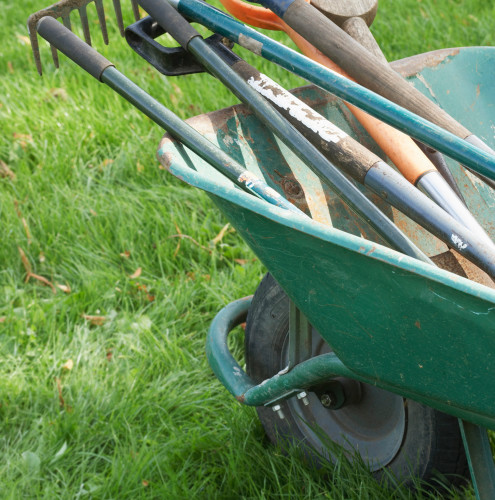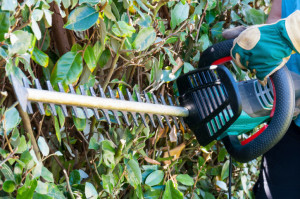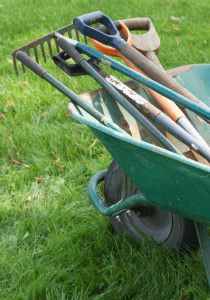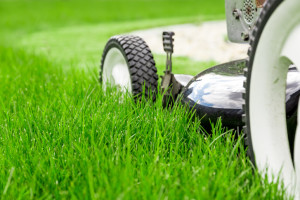
Spring is here, right? Well, it was for a couple days and boy did they feel GREAT! Midwesterner’s know to remain patient for consistent warm temperatures, but it doesn’t stop us from day dreaming, as we stare out our windows, ready to break from hibernation. Our yards look sad – dreary – flat. They haven’t felt the love of our hands in almost 6 months…and it’s time we take what we can into our own hands and itemize our SPRING CLEANUP LIST so that, when the time comes – we can hit the ground running!
IT’S PRUNING TIME
We have officially entered PRUNE season and need to take advantage of the next few weeks. The most obvious pruning job is to cut off any broken or badly disfigured branches caused by winter’s snow and ice. The rest can get tricky…here is a list of plants you can (YES!) and cannot (NO!) prune.

The sounds of spring…pruning!
YES! – Flowering Shrubs that Bloom Later in the Season. If you want to control size, the time to cut is before new growth starts. This will allow new wood to grow, buds to form, and flowers will open sometime between late June and late summer, depending on the species. Species: Abelia, Beautyberry, Butterfly Bush, Clematis, (our native) Smooth Hydrangeas, Panicle Hydrangeas, Potentilla, Roses, Rose-of-Sharon, Shrub Dogwoods, Japanese Spirea, St. Johnswort and Summersweet
YES! – Broad leaf Evergreens Species: Holly, Boxwoods and Yews
YES! – Shade Trees Species: Oak, Sweetgum, Maple, Katsura and Hornbeam
NO! – Flowering Shrubs that Bloom on “Old” Wood. These are the shrubs that sprouted flower buds late last summer or fall. Pruning old wood shrubs will cut off the buds that would’ve opened in these coming weeks of spring.
NO! – Early-Blooming Flowering Shrubs. Many of these are already showing swelling green buds, and in a few cases, the first flowers of the season. The best time to prune spring-blooming shrubs is right after the spring flowers fade. Species: Azalea, Beautybush, Bridalwreath, Spirea, spring-blooming Clematis, Cotoneaster, Deutzia, Enkianthus, Flowering Almond, Forsythia, Mophead Hydrangeas, Lilac, Mock Orange, Mountain Laurel, Ninebark, Oakleaf Hydrangea, Pieris, Rhododendron, Viburnum, Virginia Sweetspire, Weigela, Wisteria and Witch Hazel
NO! – Spring-Flowering Trees. Wait until after they bloom to prune. Species: Dogwood, Redbud, Cherry, Pear and Magnolia
DE-LEAFING 101

Spring clean-up essential tool-kit!
Raking and yard clean-up has become so obsessive for us, that even the smallest amount of yard debris gets us paranoid about what the neighbors might think.
OCD yard maintenance isn’t terrible, but let me lessen your burden and give you a quick 1,2,3 for HEALTHY doses of yard clean-up.
- Large broken limbs and debris – you bet, GET THEM off the lawn and out of your way!
- Leave thin layers of leaves in your landscape beds and simply mulch over them later; they break down and add wonderful organic matter to your soil. Leave a moderate amount of leaves on the lawn and simply mow them in with the season’s first cut; again they will break down and add organic matter and nutrition to the soil.
- Removal needs to happen when the layer of leaves over the lawn is too thick to mow or when leaves are covering evergreen ground-cover beds. In addition, rake leaves that have piled up against the house.
Don’t forget, leaves are also a GIFT from nature: add leaves to compost piles or run-over them with a mower to use as mulch in vegetable or flower beds.
WEED PREVENTION
Take advantage of the fresh start for your lawn and take these measures to eliminate Crabgrass and other annual grassy weeds.

Mowing height can make the difference between a weedless or weeded lawn
Non-Chemical Methods:
- Lawns mowed over 2½ inches have less problems with annual grassy weeds
- Over-Seeding; i.e. growing a dense and vigorous grass are the best way to prevent weeds from invading
- Core Aeration and Dethatching reduce compaction and improve chances for healthy grass growth
- Topdress with organic matter
- Regular and steady irrigation
Chemical Methods:
- Pre-emergence herbicides (weed killers) prevent annual grassy weeds and crabgrass from emerging. Herbicides should be applied before the weeds and crabgrass emerge from the soil. For us, that means late April to early May is the best time for applying a pre-emergence herbicide.
Your SPRING CLEANING list is COMPLETE…now go ahead and enjoy some March Madness before turning your full attention to that eager yard!
